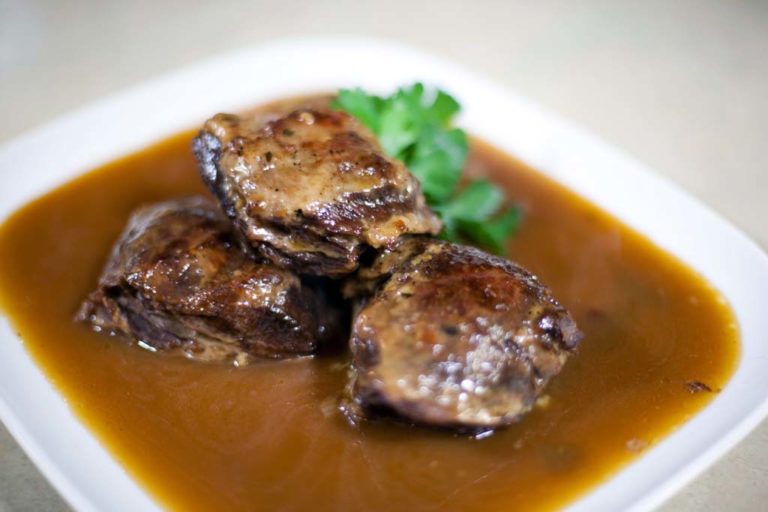
Chef's notes:
Veal cheeks aren’t something you run into on a daily basis. In fact, you may have a hard time tracking them down altogether. I found them at a small boutique butcher shop that I visit often. You could say that veal cheeks are a delicacy, but they are still meat—mouth meat, which some of you may not be comfortable with. Personally, I love the cheek meat, and I know for a fact I am not the only one. Cheek, along with tongue and other offal-type items, is becoming extremely popular on the menu at some of the better restaurants. Be on the lookout and try them when you get the chance.
Ingredients
- 4 veal cheeks
- 1 bottle dry white wine (sav. blanc)
- ⅔ cup carrots, diced small
- ½ cup leeks, diced small ½ onion, medium diced
- 5 cloves garlic, smashed and minced
- 15 sprigs Italian parsley
- 4 sprigs thyme
- 2 bay leaves
- ¼ cup all-purpose flour
- 2 tsp sea salt
- 1 tsp black pepper
- Olive oil for frying
- 2‒3 cups marinade (strained, vegetables set aside)
- 2‒3 cups veal stock (or chicken)
Veal Cheek Recipe: Marinated and Braised in White Wine and Veal Stock with Mirepoix, Garlic, and Herbs
- Assemble the ingredients for the marinade. This marinade is very simple, composed of wine, vegetables, and herbs. The nice thing about this marinade is that once done marinating, it becomes part of the braising liquid. The type of wine is flexible; just make sure it’s white and dry—as in, not sweet.
- Boil off the alcohol in the marinade. Add all the marinade ingredients to the pan and simmer over medium heat. Once the marinade breaks a boil, begin trying to light it with a lighter. Be careful because the flames can be quite large at first. Once the fire dies and you are unable to relight it, all the alcohol has been cooked off.
- Marinate the veal cheeks overnight. We cook off the alcohol to keep the marinade from “cooking” the veal cheeks. A bag works best for marinating, as you can squeeze out all of the air. Cool the marinade before pouring it over the veal cheeks.
- Dredge the veal cheeks and brown them on all sides. The next day, remove the veal cheeks from the marinade and pat them dry with paper towels. Dredge them in a mixture of salt, pepper, and flour. Heat a little olive oil in a nonstick pan and brown the veal cheeks on all sides. Then set the veal cheeks on a plate to rest.
- Strain the marinade, reserving the liquid and the vegetables separately. Toss the vegetables into the same frying pan the veal cheeks were in; saute them until softened and lightly browned. Meanwhile, heat the marinade to a simmer in a saucepan and skim off any scum that rises to the top.
- Add the braising liquids to the braising pan with veal cheeks and vegetables. Preheat the oven to 350 degrees F. Lay the veal cheeks and vegetables in the bottom of the braising pan; pour the veal stock and reserved marinade over the top. Place the lid in the braising pan and put it into the oven for an hour.
- Braise the veal cheeks for 3‒4 hours in a 350 degree oven. Flip the veal cheeks after every hour of braising. This will help them to cook evenly. Once the veal cheeks have braised for 3+ hours, they should be done—as in, fork tender. Set them on a plate to rest, covered with foil, while you strain the solids out of the braising liquid. Reduce the strained braising liquid until thick like a sauce or gravy. Adjust the seasoning and serve with the cheeks.
Tips & Tricks
- You could substitute beef cheeks for this dish. Just switch out the dry white for a dry red, and the veal stock for beef stock. No point in using up your precious veal stock on beef. You could even add a little tomato paste toward the end if you wanted. Also, add some mushrooms or even roasted garlic.
- Tying a bouquet garni is easy. Just grab everything together and wrap a piece of butcher’s twine around the base twice. Then tie a double square knot and trim off the excess string.
- The veal cheeks should be pre-cleaned by your butcher. If not, ask them kindly if they will.
- Reducing the braising liquid until it is thick may take time. And if you used store-bought stock, it may become salty or may not thicken up because of a lack of gelatin. If that’s the case, you may have to add a little arrowroot—or roux—to thicken it.
- Don’t adjust the seasoning until you have finished reducing the braising liquid.
